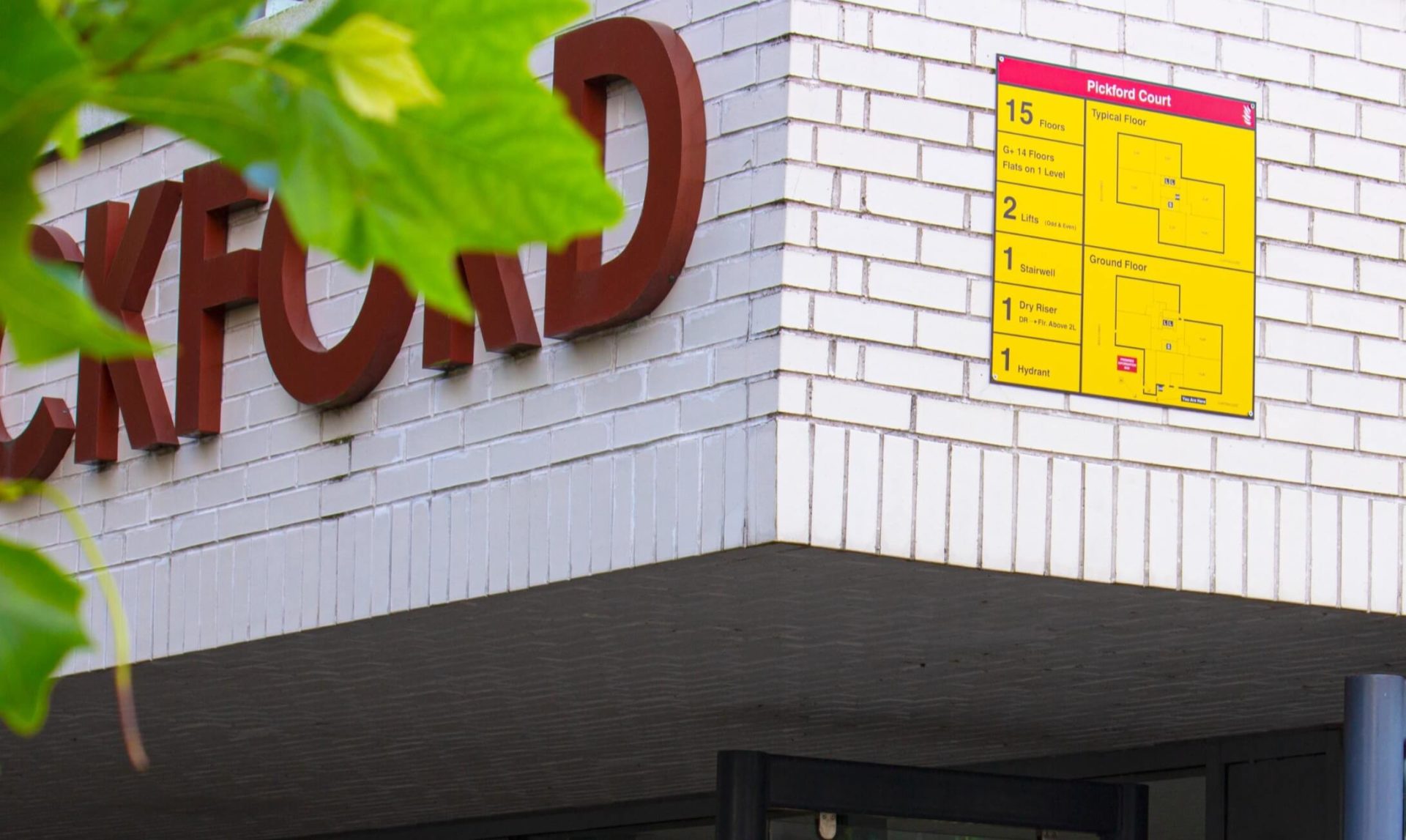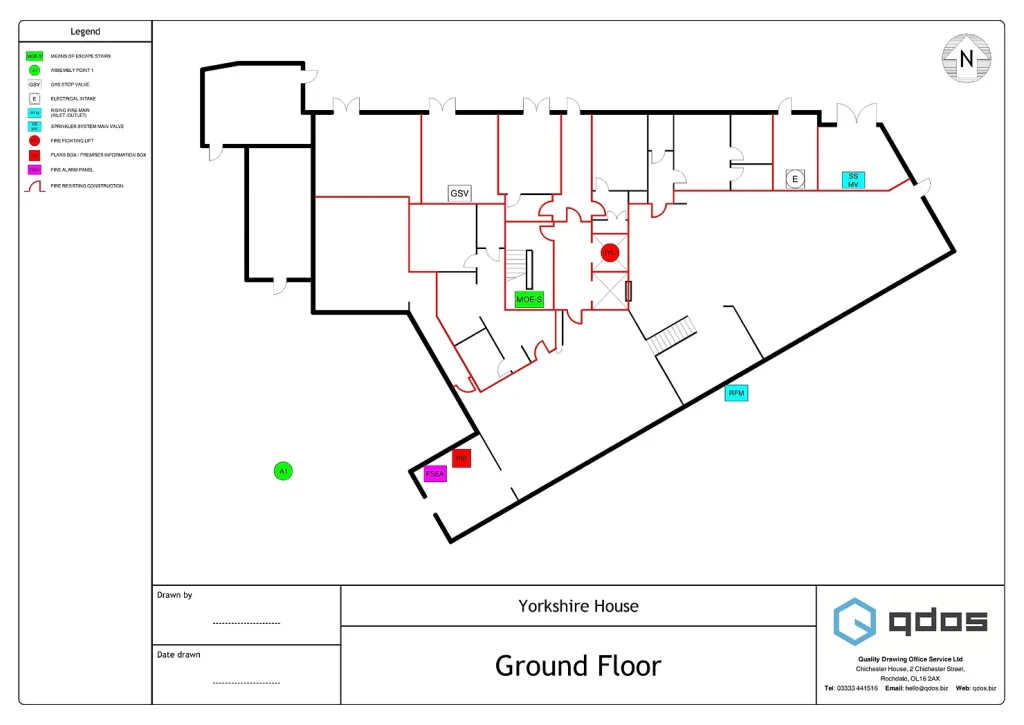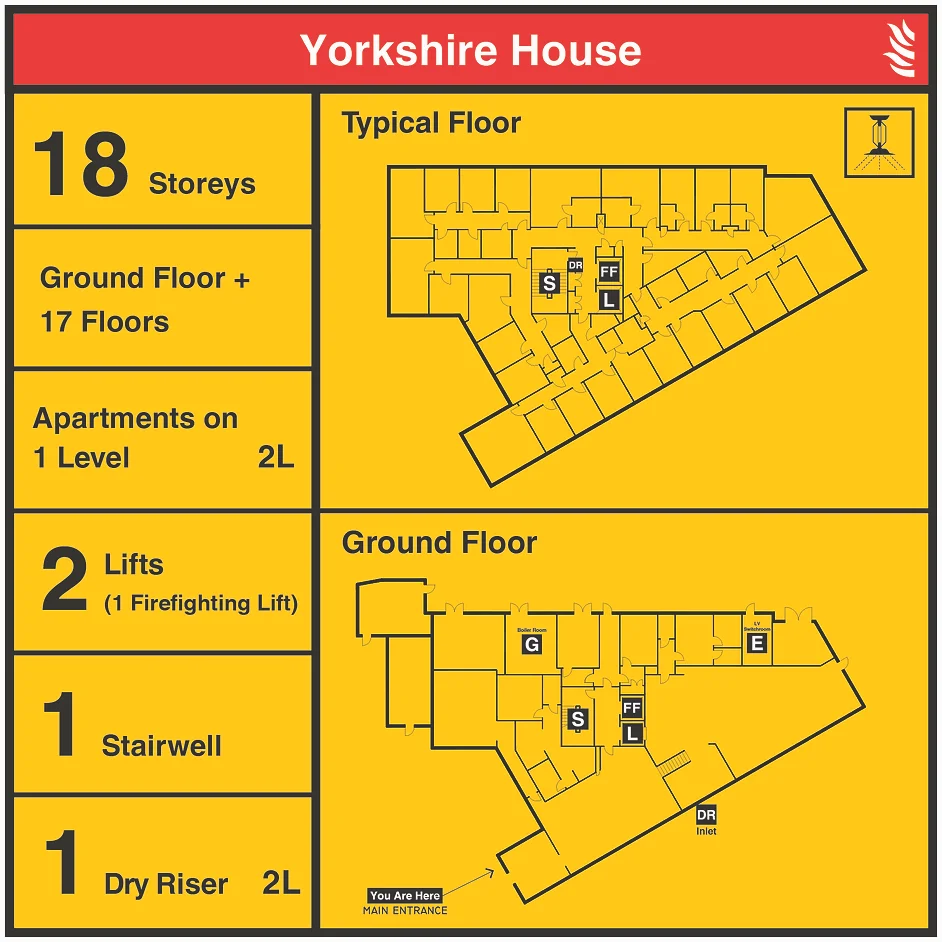News & INSIGHTS
legal requirement
On January 2023, the Fire Safety (England) Regulations 2022 made it a legal requirement for ‘Responsible Persons’ looking after high-rise residential buildings in England to draw up and share electronically up-to-date floor plans identifying the location of key firefighting equipment.
This guide is for property mangers and those responsible for fire safety in high rise residential buildings. It provides the background to the regulations, and details what you need to do to comply with the law. All of this aims to ensure that in the event of a fire in a high-rise residential building, the Fire and Rescue Services have accurate information from which to make crucial decisions quickly.
At QDOS we have over 25 years’ experience in the fire and safety industry and are the UK’s leading trade supplier of bespoke fire safety plans . We’re here to support you.

Background to the Fire Safety (England) Regulations 2022
The Grenfell Tower Inquiry Phase 1 report found that, on the night of the Grenfell Tower Fire on 14 June 2017, no plans of the internal layout of the building were available to the London Fire Brigade who were on the scene.
The people presiding over the Inquiry have subsequently recommended, that the owner and manager of every high-rise residential building in England is required by law to provide crew members from attending Fire and Rescue Services with up-to-date plans for every floor of the building that identify the location of key fire safety systems.
The floor plans and additional single-page building plan, which clearly indicates the location of key firefighting facilities such as dry risers, are designed specifically to assist Fire and Rescue Services in planning for operational responses to a fire, saving crucial intervention time.
The Fire Safety (England) Regulations 2022, made under article 24 of the Regulatory Reform (Fire Safety) Order, will fulfil the Grenfell Tower Inquiry’s recommendation on building plans and go a step further with the single-page building plan.
In June 2022 the Fire Industry Association (FIA) published the Code of Practice for the Provision of Premises Information Boxes in residential buildings.
.The Code of Practice’s appendices also includes the provision of up-to-date information to help with the emergency evacuation/rescue of people with mobility cognitive or sensory impairment.
How should floor plans be prepared?
A plan needs to be provided for each floor of the structure but, where multiple floors are identical, only one plan is required. Plans must clearly show the level of the structure they represent. If the plan covers more than one identical level, then the range of levels needs to be shown.
The ‘Responsible Person’ is also required to provide their local Fire and Rescue Service with the additional single-page building plan, which should include the location of all key firefighting equipment. The plan should be simple and proactively help operational firefighters attending any incident to make critical decisions quickly.
Floor plans need to be prepared like this:

Single page building plans
This should be a simple plan of the ground floor, detailing access and egress points for the structure, assembly points and rising fire mains. It should deliver a good single-page overview of the building and firefighting equipment.

Premises Information Plate
An additional way to display this information is with a Premises Information Plate.
Back in 2019, at QDOS we created a building plan that’s designed to provide a comprehensive overview of a high-rise building. This Premises Information Plate can be displayed as a permanent fixture on the outside of the building close to the entrance or arrival point for Fire and Rescue Services. It gives the first responders at an incident clear information they need on arrival.
The regulations require that plans provided for the Fire and Rescue Service are a ‘reasonably accurate’ reflection of each floor of the building. Ideally you should have scaled plans available electronically from professional plan drawing software. Where these plans don’t exist, obtaining any plans relating to the building – specifically focused on fire safety or otherwise – is a good start and these can then be thoroughly checked on site for accuracy. The plans should be proportionate and serve as an accurate representation of the layout of the building. Showing, as a bare minimum, key information including access points, common circulation areas, stairs, lifts and accommodation division.
Once old plans have been checked , or buildings sketched with this information, these can be used to create the finished electronic files ready for printing the plans, then manufacturing vandal-resistant Premises Information Plates and sharing them with Fire and Rescue Services.
Remember, all plans should be subjected to detailed review on a regular basis and updated if the layout of the building or equipment identified on the plans changes in any way.
Electronic Files
QDOS Managing Director Damian Linley says: “There are several options for software that can be used to prepare the finished building plans to satisfy the requirements of the Fire Safety (England) Regulations 2022.
The main issue is sharing these electronic files. You can achieve this by exporting or saving the finished drawings in PDF format. That said, adequate computer-aided design (CAD) software should be used. The electronic files should be editable. ‘PDF mark-up’ software or apps are accurate for the first drawings, but any building changes deemed necessary in the future would require a full updated floor plan to be sourced and imported into one of these programs.
Professional CAD software like we use at QDOS can cope with changes quickly and efficiently thanks to an editing process for the original files. And you can keep hard copies of these plans inside the Secure Information Box on the premises. This is to provide firefighters on scene with readily accessible information about the building. The hard copies can supplement the electronic copies of plans that have been sent by the ‘Responsible Person’ to the local Fire and Rescue Service. There’s no requirement – or intent – for ‘Responsible Persons’ to send a hard copy to the local Fire and Rescue Service.”
Wayfinding Signage
Damian also says that the Grenfell Tower Inquiry Phase 1 report notes that, inside the building, stairwell landings were not clearly marked with the relevant floor number and so the firefighters attending weren’t able to easily identify floors when carrying out their duties on the night.
Those people presiding at the Public Inquiry have recommended that, in all high-rise buildings “floor numbers be clearly marked on each landing within the stairways and in a prominent place in all lobbies in such a way as to be visible both in normal conditions and also in low lighting or smoky conditions.”
He adds: “There is a requirement to install wayfinding signage in buildings, which includes clear markings identifying floor and individual flat numbers. In the event of a fire, the installation of such signage in existing high-rise residential buildings can greatly assist Fire and Rescue Services in navigating their way around the premises even when visibility is at a low level due to the prevalence of smoke arising from a blaze.”
Signage should conform to the specifications and location set out in paragraph 15.3 to 15.6* of Approved Document B Volume 1 (2019 Edition incorporating 2020 amendments).
Approved Document B addresses fire safety precautions which must be observed to ensure the safety of occupants , firefighters and those close to the building in the event of a fire. It’s worth detailing the exact specifications outlined in paragraph 15.3 to 15.5*.
Floor Designation
There are further requirements about wording used on each floor identification sign and what form they should take**.
For multi-storey flats with two or more entrances, the flat number should only be indicated on the normal access storey.
Signage should conform to the specifications and location set out in paragraph 15.3 to 15.6 of Approved Document B Volume 1 2019 Edition incorporating 2020 amendments.
Storage of Hard Copies
Hard copies of your plans should be kept in the secure information box on the premises. This is to provide firefighters with readily accessible information about the building. Hard copies can supplement the electronic copies of plans sent by responsible persons to the local Fire and Rescue Services. There is no requirement or intent for ‘Responsible Persons’ to send a hard copy to their local Fire and Rescue Service.
For help and support completing your plans contact QDOS on 03333 441516 or visit our Premises Information page here.
*15.3: To assist the Fire and Rescue Service to identify each floor in a block of flats with a top storey more than 11 metres above ground level, floor identification signs and flat indicator signs should be provided.
15.4: The floor identification signs should meet all of the following conditions: (a) The signs should be located on every landing of a protected stairway and every protected corridor/lobby (for open access balcony) into which a firefighting lift opens (b) The text should be in sans serif typeface with a letter height of at least 50mm. The height of the numeral that designates the floor number should be at least 75mm (c) The signs should be visible from the top step of a firefighting stair and, where possible, from inside a firefighting lift when the lift car doors open (d) The signs should be mounted between 1.7 metres and 2 metres above floor level and, as far as practicable, all the signs present should be mounted at the same height (e) The text should be on a contrasting background, easily legible and readable in low-level lighting conditions or when illuminated with a torch.
**15.15: The wording used on each floor identification sign should take the form ‘Floor X’ with X designating the number of the storey, as intended reference by residents. The floor number designations should meet all of the following conditions (a) The floor closest to the mean ground level should be designated as either Floor 0 or the Ground Floor (b) Each floor above the ground floor should be numbered sequentially beginning with Floor 1 (c) A lower ground floor should be designated as either Floor -1 or the Lower Ground Floor (d) Each floor below the ground floor should be numbered sequentially beginning with Floor -1 or Basement 1.
15.16: All floor identifications signs should be supplemented by flat indicator signs, which provide information relating to the flats accessed on each storey. The flat indicator signs should meet all of the following conditions (a) The signs should be sited immediately below the floor identifications signs, such that the top edge of the sign is no more that 50mm below the bottom edge of the floor identification sign (b) The wording should take the form Flats X-Y, with the lowest number first (c) The text should be in sans serif typeface with a letter height of at least half that of the floor indicator sign (d) The wording should be supplemented by arrows when the flats are in more than one direction. (e) The text and arrows should be on a contrasting background, easily legible and readable in low-level lighting conditions or when illuminated with a torch.
Follow us
LinkedIn: QDOS
Instagram: @qdos.biz Twitter: @QDOSCAD
Trusted by
Contact Us
Fill out our contact form below with your enquiry and one of our team will get back to you ASAP.